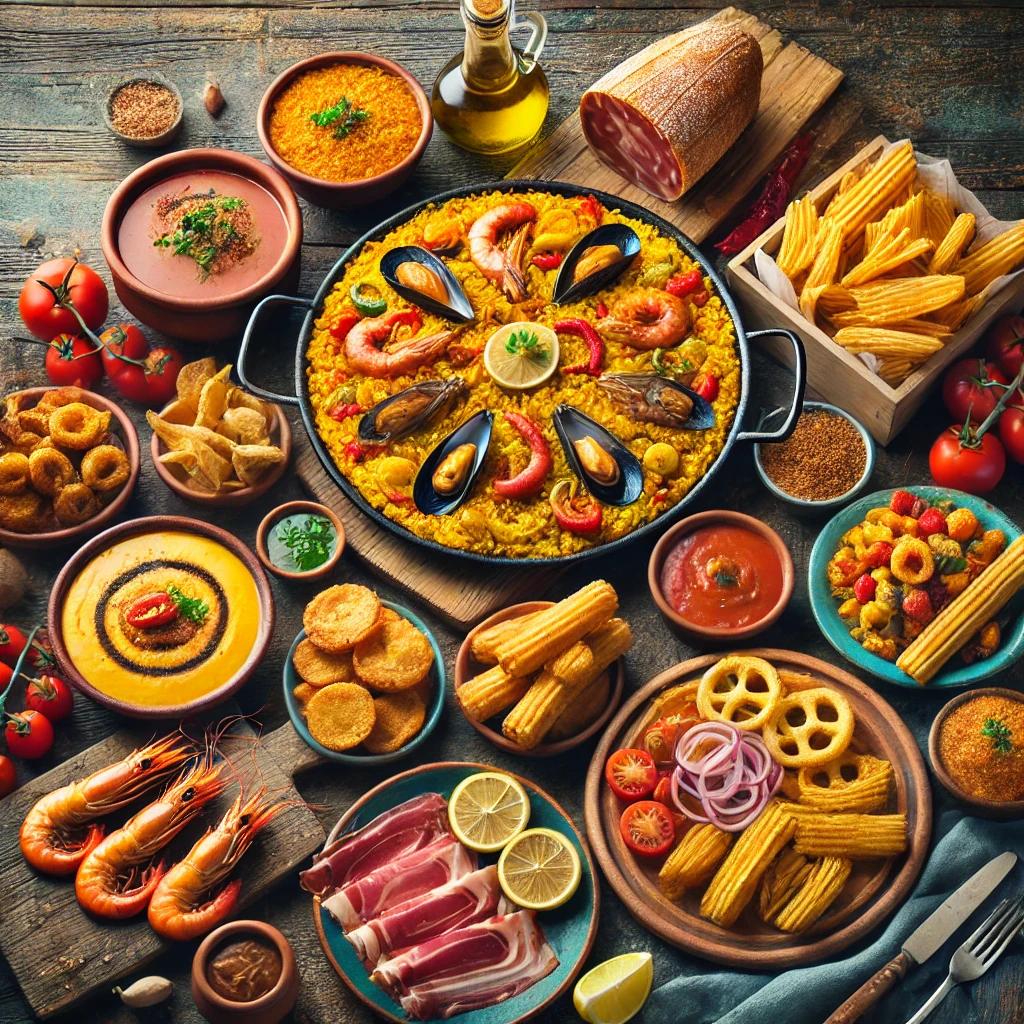Beautiful Traditional Spanish Food.
Spain is renowned for its stunning landscapes, passionate culture, and vibrant festivals. But what truly sets it apart is its incredible culinary tradition. Traditional Spanish food is deeply rooted in the country’s diverse regions, blending simple, high-quality ingredients with centuries-old techniques that make every meal a cultural experience. From the coastlines of Galicia to the sun-soaked plains of Andalusia, the food of Spain tells a story of history, geography, and community. Let’s embark on a flavorful journey and explore some of the best traditional Spanish food you must enjoy.
1. Paella: Spain’s Iconic Dish
When one thinks of traditional Spanish food, paella often comes to mind. Originating from the coastal city of Valencia, paella is a dish that beautifully showcases Spain’s diverse ingredients and regional flavors. At its heart is rice, cooked in a wide, shallow pan and infused with saffron, which gives it a distinctive golden hue. Paella can be made with a variety of ingredients, but the most popular versions are paella de marisco (seafood paella) and paella mixta (a combination of meat, seafood, and vegetables).
The magic of paella lies in its socarrat—the crispy, caramelized layer of rice that forms at the bottom of the pan, adding texture and depth of flavor. Paella is best enjoyed with friends and family, often served in large portions for sharing. Whether you’re eating it by the Mediterranean Sea or at a small local restaurant, paella captures the essence of traditional Spanish food: simplicity, flavor, and community.
2. Tapas: A Small Bite, Big Flavor
If paella is Spain’s signature dish, then tapas are its most beloved way of eating. Tapas are small plates or snacks that are typically enjoyed with drinks in social settings. What makes tapas so special is their diversity—each region of Spain has its own unique interpretation. In Andalusia, you’ll find fried fish and jamón ibérico; in the Basque Country, pintxos (skewered snacks); and in Madrid, classic dishes like tortilla española and patatas bravas.
The tradition of eating tapas is more than just food—it’s a social ritual. Friends gather at a tapería or bar, order a round of drinks, and sample different small plates while chatting and enjoying each other’s company. Tapas embody the spirit of traditional Spanish food: accessible, varied, and full of flavor. Some must-try tapas include:
- Tortilla Española: A thick omelette made with eggs, potatoes, and onions, often served cold.
- Croquetas: Creamy bechamel fritters, usually filled with ham, chicken, or fish.
- Albóndigas: Spanish meatballs, often served in a rich tomato sauce.
- Pimientos de Padrón: Small, fried green peppers, some of which can be surprisingly spicy!
3. Jamón Ibérico: The King of Spanish Cured Meats
Spain is home to some of the finest cured meats in the world, and none is more revered than jamón ibérico. This delicacy is made from the hind legs of Iberian pigs, which are fed a diet of acorns, giving the meat its distinctive flavor. A true representation of traditional Spanish food, jamón ibérico is a symbol of the country’s culinary excellence and dedication to quality.
The process of producing jamón ibérico is long and meticulous. The hams are salted and left to dry for several weeks, then aged for up to three years in special curing cellars. The result is a melt-in-your-mouth texture with a deep, nutty flavor. Whether sliced thinly and eaten on its own or paired with bread and cheese, jamón ibérico is a treat for the senses.
When visiting Spain, you’ll often see large hams hanging from the ceilings of specialty shops and restaurants. Locals take pride in their jamón, and rightly so—it’s a perfect example of how traditional Spanish food celebrates craftsmanship and patience.
4. Gazpacho and Salmorejo: Cool, Refreshing Soups
Spain’s hot summers call for cool, refreshing meals, and that’s where gazpacho and salmorejo come in. Both of these chilled soups originate from Andalusia, a region known for its intense heat. Gazpacho, a lighter soup made from tomatoes, cucumbers, peppers, garlic, olive oil, and vinegar, is typically served as an appetizer or a drinkable snack. It’s vibrant, tangy, and refreshing—a perfect antidote to the summer sun.
Salmorejo, on the other hand, is a heartier version of gazpacho, made with fewer vegetables and more bread, which gives it a thicker, creamier consistency. It’s often topped with hard-boiled eggs and slices of jamón ibérico for added texture and flavor. Both gazpacho and salmorejo are quintessential examples of traditional Spanish food, showcasing the country’s ability to make the most of simple, local ingredients.
5. Churros and Chocolate: Sweet Indulgence
No discussion of traditional Spanish food would be complete without mentioning churros—crispy, fried dough sticks that are often dipped in thick, velvety hot chocolate. While churros can be eaten at any time of day, they’re especially popular for breakfast or as a late-night snack after a night out. In cities like Madrid, churrerías (churro shops) stay open late into the night, serving locals and visitors alike.
The best churros are crispy on the outside and soft on the inside, with just the right amount of sugar sprinkled on top. The chocolate, meanwhile, is thick and rich, perfect for dipping. Whether you’re enjoying them at a local café or at a bustling market, churros and chocolate offer a sweet taste of Spain’s culinary traditions.
6. Pulpo a la Gallega: Galicia’s Octopus Specialty
From the northern region of Galicia comes one of the most beloved traditional Spanish food dishes: pulpo a la gallega (Galician-style octopus). Galicia, with its rugged coastline and abundant seafood, is famous for its octopus, and this dish is a testament to the region’s culinary prowess.
Pulpo a la gallega is simple yet incredibly flavorful. Tender octopus is boiled, then seasoned with olive oil, coarse salt, and smoky paprika, and served on a wooden plate, often accompanied by potatoes. The octopus is incredibly tender, with a slight smoky flavor from the paprika, making it a dish that truly highlights the natural flavors of the sea.
In Galicia, pulpo a la gallega is often enjoyed during fiestas and local festivals, where it’s served in large portions for everyone to share. It’s yet another example of how traditional Spanish food is intertwined with community, celebration, and local pride.
7. Tarta de Santiago: A Sweet Slice of History
For those with a sweet tooth, tarta de Santiago is a must-try dessert. This almond cake hails from the region of Galicia and is often associated with the famous pilgrimage route, the Camino de Santiago. Made from ground almonds, eggs, and sugar, tarta de Santiago is dense, moist, and subtly sweet, with a delicate almond flavor.
The cake is traditionally dusted with powdered sugar in the shape of the Cross of Saint James, adding a beautiful, symbolic touch. Tarta de Santiago is often enjoyed with a cup of coffee or a glass of dessert wine, making it a delightful end to any meal. As a part of traditional Spanish food, this cake holds a special place in the hearts of Galicians and pilgrims alike.
Conclusion
Traditional Spanish food is much more than just sustenance—it’s an expression of the country’s rich history, diverse landscapes, and vibrant culture. From the seafood-rich coasts of Galicia to the sun-soaked orchards of Valencia, Spain’s culinary offerings are as varied as they are delicious. Whether you’re indulging in the hearty flavors of paella, savoring the simple pleasures of tapas, or treating yourself to a sweet bite of churros, every meal is an opportunity to experience Spain’s culinary heritage.
So next time you find yourself in Spain, make sure to enjoy a meal that reflects the beauty and warmth of the country. Traditional Spanish food is not just something to eat; it’s something to be savored, shared, and celebrated.


